The fragrance wheel helps you create professional-quality DIY perfumes by organizing scents into four main families: floral, woody, fresh, and amber. You'll blend complementary notes from opposite sides for dynamic contrasts or adjacent scents for harmony. Start with a balanced composition of 30% top notes, 50% middle notes, and 20% base notes. Add fixatives like vanilla or musk to enhance longevity. Understanding these principles will transform your perfume-making journey from basic mixing to artful fragrance design.
Understanding the Core Elements of the Fragrance Wheel
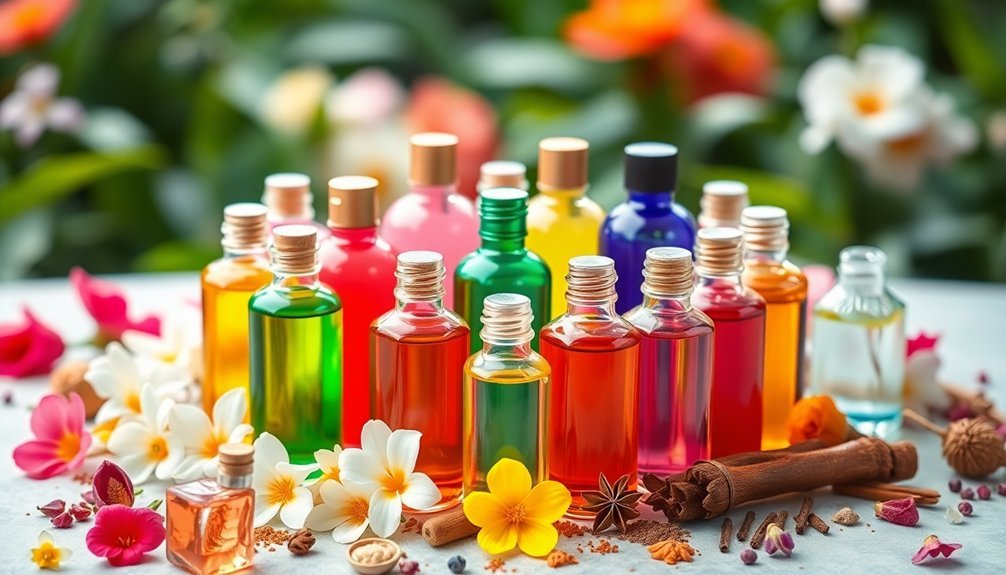
Anyone seeking to create their own perfume must first grasp the fundamental tool of fragrance design: the fragrance wheel. Developed by Michael Edwards, this essential guide breaks down all aromatic notes into four main scent families: floral, woody, fresh, and amber.
You'll find these primary categories further divided into subfamilies, giving you a more precise way to classify and understand different scents.
The wheel's genius lies in its visual arrangement, showing you how different fragrance families relate to each other. You can easily identify complementary notes by looking at opposite sections of the wheel, while adjacent families represent kindred scents that naturally blend well together.
Whether you're just starting or you're an experienced perfumer, this systematic approach helps you create balanced, unique fragrances with confidence.
Essential Natural Ingredients for Each Scent Family
When diving into natural perfumery, you'll need to familiarize yourself with the key ingredients that define each scent family. Different fragrance families require specific natural ingredients to achieve their distinctive scent profile.
For floral scents, you'll want essential oils from jasmine, rose, and ylang-ylang to create that enchanting sweetness.
Woody fragrances come alive with sandalwood, cedar, and vetiver, while fresh fragrances depend on citrus essential oils from lemons, oranges, and bergamot for their energizing appeal.
If you're crafting amber scents, incorporate vanilla, benzoin, and myrrh to achieve that characteristic warmth.
For gourmand fragrances, focus on natural extracts from vanilla, cocoa, and caramel to create those deliciously sweet notes that make these scents so appealing.
Blending Techniques Using the Fragrance Wheel
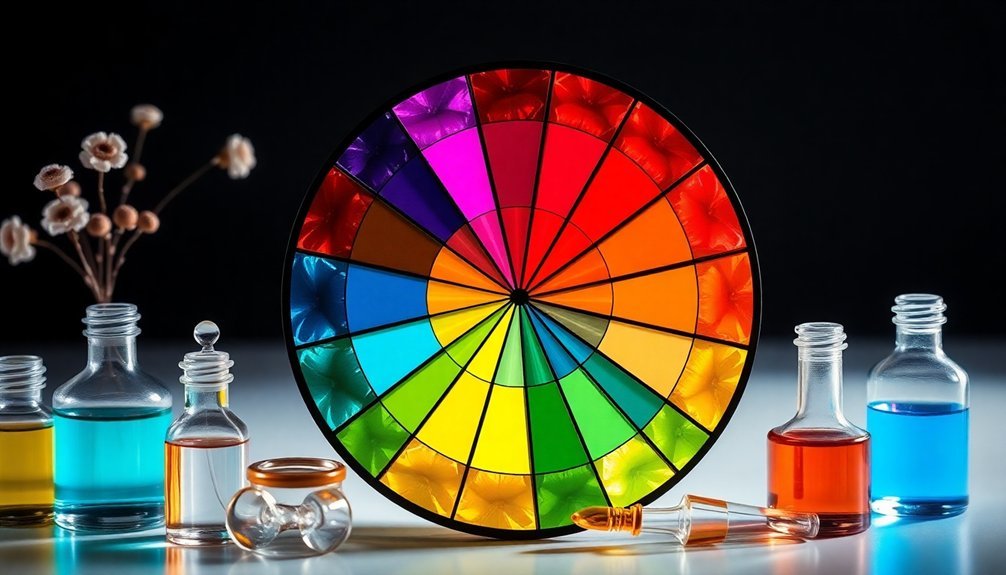
You'll find the fragrance wheel invaluable when crafting your own perfumes by using complementary scents from opposite sides, like amber with ozonic notes, to create dynamic contrasts.
When you want more harmonious blends, select adjacent scents on the wheel, such as floral and fruity notes, which naturally enhance each other.
For added complexity in your DIY fragrances, try the triangle technique by selecting three notes from different wheel segments that form a triangular shape.
Complementary Scent Pairing Rules
Three fundamental principles guide complementary scent pairing on the fragrance wheel.
When you're working with opposite scent families, you'll need to understand how these contrasting notes combine to create unique and balanced fragrances. Warm scents and fresh notes can blend well when you follow the proper proportions and maintain harmony between the elements.
- Choose scents from opposite sides of the fragrance wheel (like Amber and Ozonic) to create dynamic combinations.
- Balance the intensity of each note, ensuring neither fragrance overpowers the other.
- Explore kindred notes (adjacent scent families) for more harmonious blends.
- Use the triangle technique by selecting three subfamilies that form a triangle on the wheel.
Layering Adjacent Fragrance Notes
Understanding adjacent notes on the fragrance wheel creates a foundation for sophisticated scent layering. When you're crafting your DIY perfume, focus on combining scents from the same fragrance family or neighboring families for a harmonious blend.
You'll find that adjacent notes naturally complement each other due to their shared characteristics. Try pairing soft floral notes with other florals, or experiment with citrus and aromatic fougère combinations for a fresh, invigorating effect.
The neighbor fragrance technique helps you expand your scent palette by exploring notes that sit next to your favorite fragrances on the wheel. For a calming layered fragrance, combine floral lavender with aromatic rosemary.
Creating Signature Scents With Complementary Notes
The art of creating signature scents comes alive when you explore the strategic pairing of complementary fragrance notes.
You'll discover that opposite families on the fragrance wheel can create dynamic and unique blends, like combining amber with oceanic notes for an intriguing olfactory experience.
Working with kindred notes, such as floral and woody scents, adds depth and balance to your aromatic fragrance.
- Mix fresh oceanic notes with warm amber for an unexpected yet harmonious blend
- Pair adjacent floral scents with woody undertones to create rich complexity
- Combine opposite fragrance families to develop distinct signature characteristics
- Balance complementary notes to achieve depth while maintaining cohesiveness
Whether you're blending kindred or complementary notes, let the fragrance wheel guide your creative journey.
You'll craft a signature scent that's both balanced and uniquely yours.
Mastering Top, Middle, and Base Note Combinations
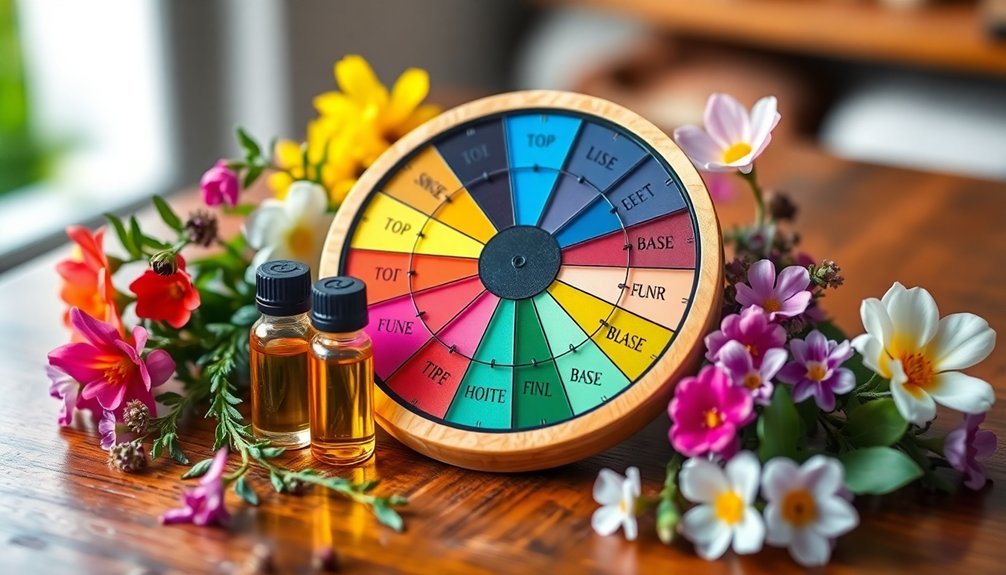
Successful perfume creation depends on masterfully layering your fragrance notes to achieve a harmonious progression of scents.
When blending DIY scents, start with vibrant top notes like citrus or light florals that'll immediately captivate the senses. These notes create your fragrance's first impression but quickly fade.
Your middle notes form the heart of your creation, emerging as the top notes dissipate. Choose from scent families like bright florals or light woods to build character and depth. These notes bridge your initial impression with the foundation of your perfume.
Finally, anchor your harmonious blend with lasting base notes. Select rich ingredients like vanilla, musk, or deep spices to guarantee longevity.
Experiment with different fragrant combinations and ratios until you achieve the perfect balance between all three layers, creating a sophisticated scent that evolves beautifully throughout wear.
Natural Alternatives for Traditional Fragrance Components
You'll find that essential oils make excellent natural base notes for your DIY perfumes, with options like vanilla absolute, patchouli, and sandalwood providing lasting foundations.
These plant-derived compounds offer both aromatic complexity and therapeutic benefits while avoiding synthetic chemicals commonly found in commercial fragrances.
Natural resins and absolutes can effectively replace artificial fixatives, giving your homemade perfume the staying power you desire without compromising on purity.
Essential Oil Base Notes
Base notes form the foundation and soul of any handcrafted perfume, anchoring your fragrance with rich, enduring scents that can last for hours after application.
When crafting DIY scents, you'll find that essential oils like cedarwood and vetiver offer natural woody characteristics that ground your blend perfectly. These oils' slow evaporation rates guarantee your fragrance maintains its complexity throughout wear.
Key natural base notes for your perfume creation:
- Sandalwood – Provides a rich, creamy foundation
- Benzoin – Adds warmth and vanilla-like sweetness
- Myrrh – Creates depth with its resinous character
- Labdanum – Offers an amber-like, leathery touch
To create a well-rounded fragrance, combine these base notes with complementary middle and top notes.
This layering technique guarantees your DIY perfume develops beautifully over time.
Plant-Derived Fragrance Compounds
Nature's vast botanical treasury offers an extensive selection of plant-derived fragrance compounds that can replace synthetic ingredients in your DIY perfume.
You'll find these natural alternatives in various plant parts, from delicate flower petals to sturdy roots, each providing unique scent profiles for your creations.
Essential oils, extracted through steam distillation and cold pressing, form the foundation of these aromatic combinations.
You can blend floral notes like rose and jasmine with woody elements such as sandalwood and cedar, creating complex, layered fragrances.
These sustainable ingredients aren't just environmentally conscious choices – they're also biodegradable and align with eco-friendliness standards.
When working with plant-derived compounds, remember to follow regulatory bodies like IFRA's safety guidelines, ensuring your natural perfume creations are both safe and compliant.
Troubleshooting Common DIY Perfume Blending Issues
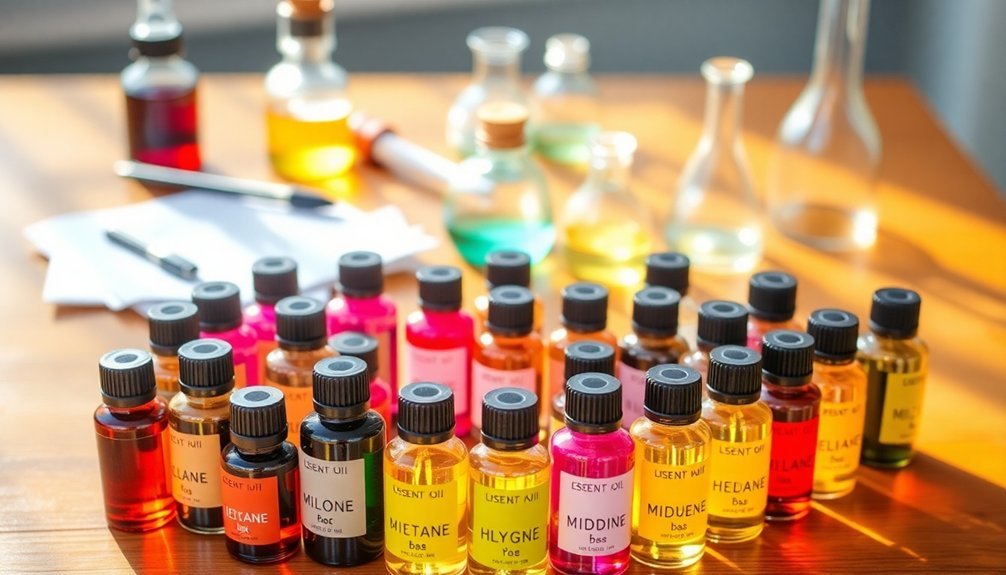
While creating your own perfume can be deeply rewarding, several common issues may arise during the blending process. Understanding how to troubleshoot these challenges will help you craft the perfect scent.
When your blend feels disjointed, try incorporating complementary notes from adjacent fragrance families to create harmony.
- Balance your composition with 30% top notes, 50% middle notes, and 20% base notes for a well-structured fragrance.
- Address overwhelming scents by diluting with carrier oil or alcohol.
- Enhance longevity by adding fixative base notes like vanilla, musk, or sandalwood.
- Fix separation issues by thoroughly mixing and allowing your blend to rest for several days.
Frequently Asked Questions
What Is the 30 50 20 Rule for Perfume?
You'll want to blend your perfume using 30% top notes for initial impact, 50% middle notes for the main character, and 20% base notes for lasting power – it's a proven formula.
How to Read a Fragrance Wheel?
Start at the center and work outward. You'll find four main families: Floral, Amber, Woody, and Fresh. Adjacent scents blend well together, while opposite notes create contrast. Look for subfamilies within each category.
What Are the 4 Categories of Fragrance?
You'll find four main fragrance categories that shape the perfume world: Floral (sweet and flowery), Amber (warm and rich), Woody (earthy and deep), and Fresh (invigorating and citrusy). Each offers distinct aromatic experiences.
How Do You Make Your Own Perfume Scent?
You'll need to blend top, middle, and base notes using essential oils, mix them with alcohol at a 20-30% concentration, and let your creation mature for 48 hours before testing on your skin.
In Summary
You've now mastered the basics of the perfume wheel and can confidently create your own unique fragrances at home. Remember to start with small batches, keep detailed notes of your blends, and don't be afraid to experiment with unexpected combinations. Trust your nose, stay patient with the process, and you'll soon develop a signature scent that perfectly captures your creative vision.
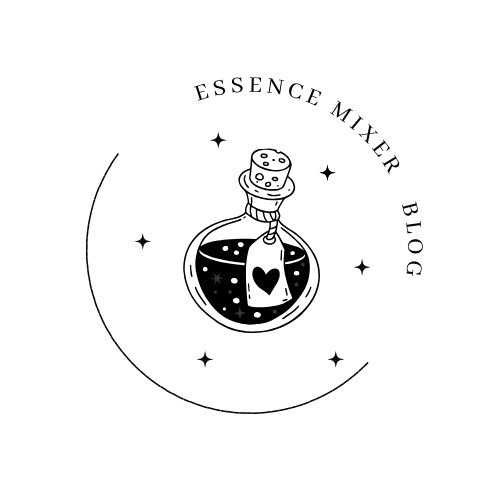
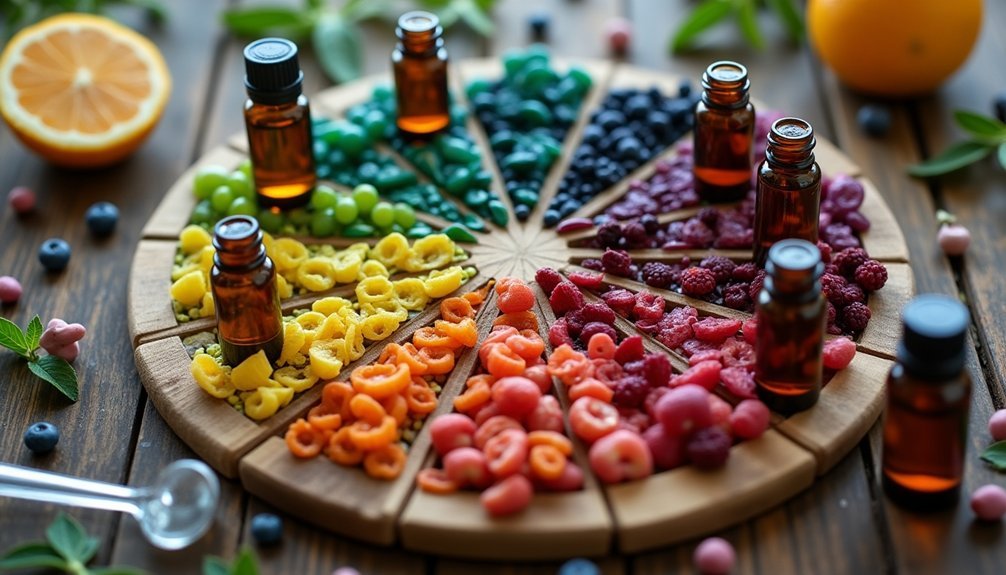



Leave a Reply